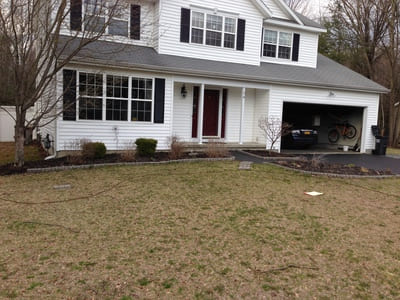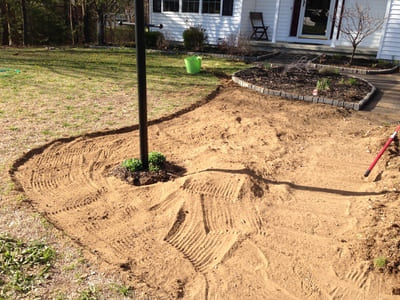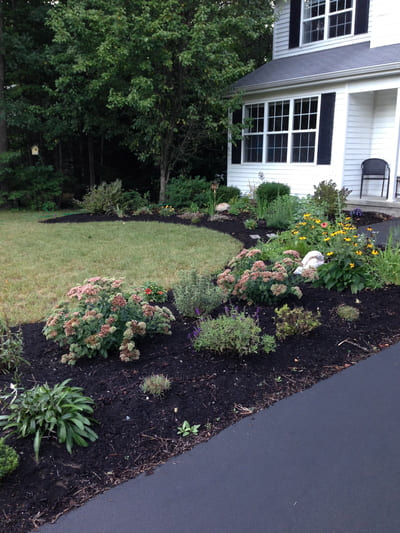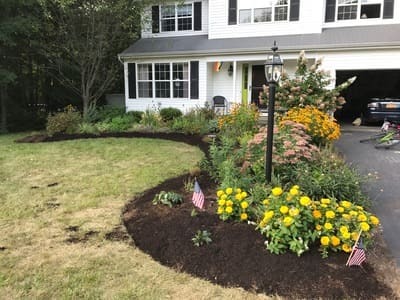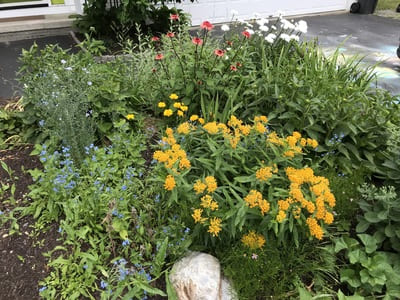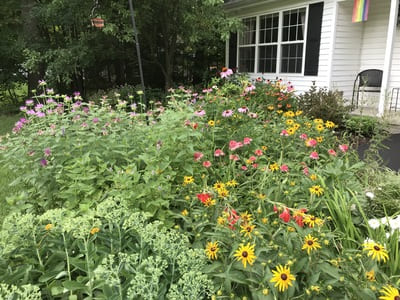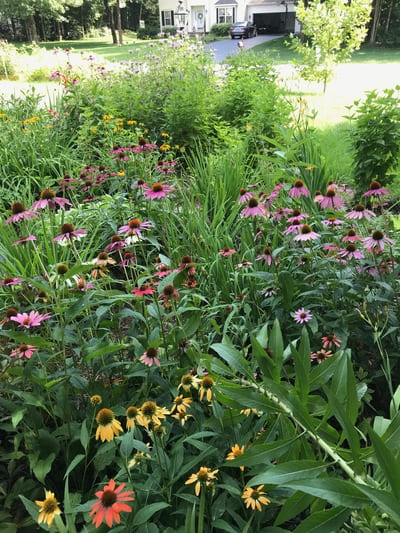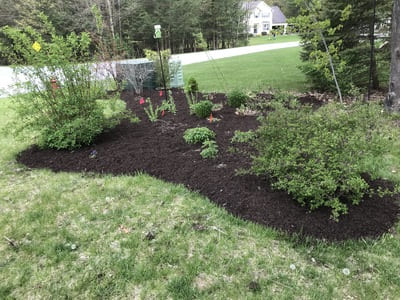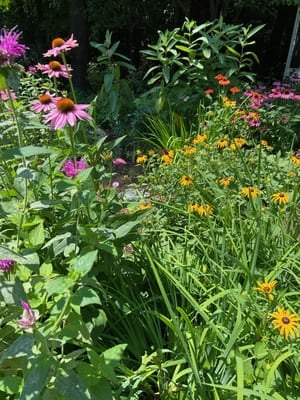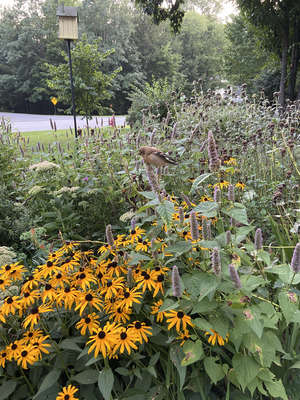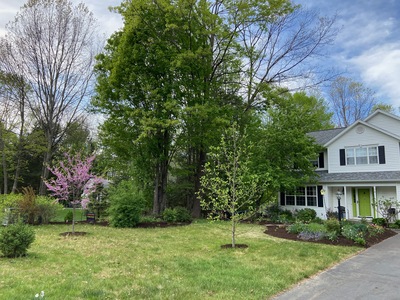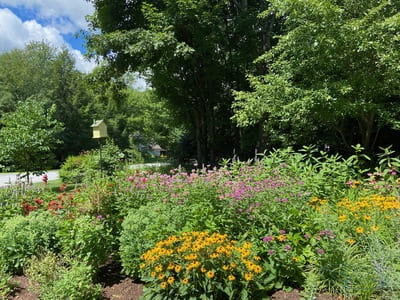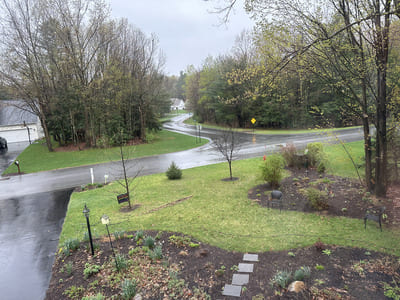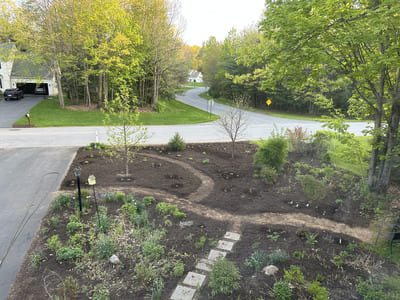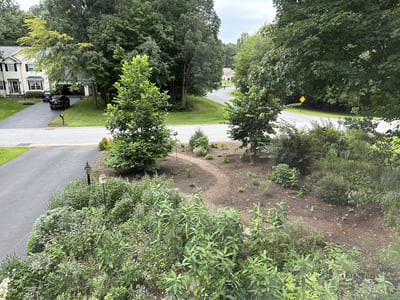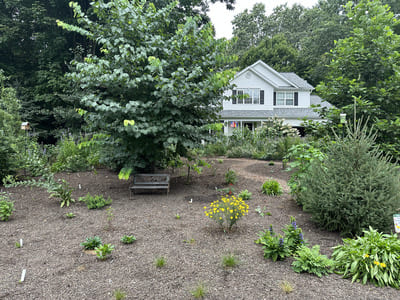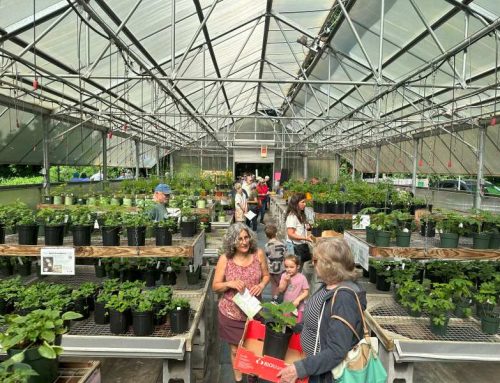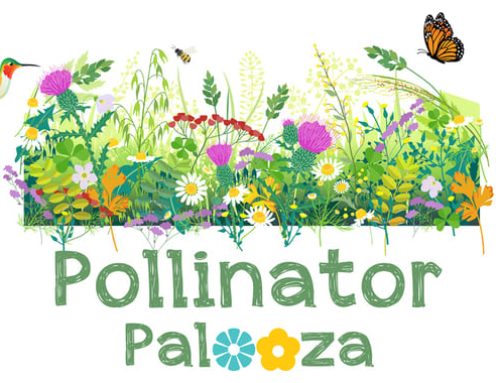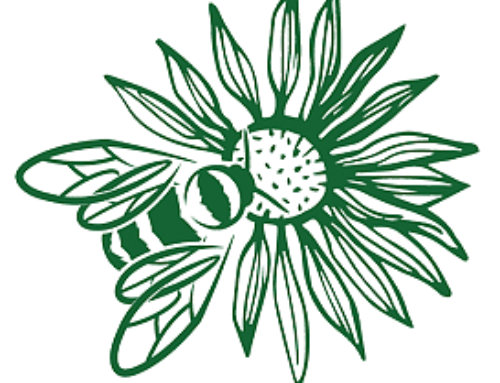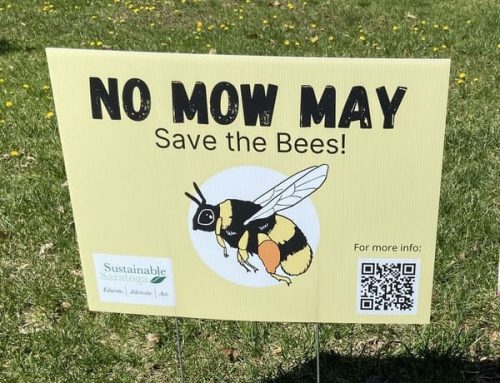Pollinator Garden Profile - Wendy Mahaney
#killyourlawn
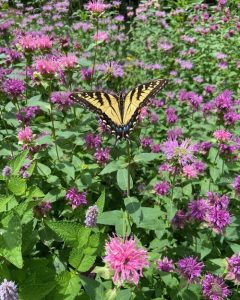 Wendy Mahaney, an environmental scientist and former executive director of Sustainable Saratoga, moved to Wilton in 2015. Since then, Wendy has slowly transformed her suburban lawn into a thriving ecosystem filled with native plants, butterflies, bumblebees, fireflies, hummingbirds, bluebirds, voles and a few ravenous bunnies.
Wendy Mahaney, an environmental scientist and former executive director of Sustainable Saratoga, moved to Wilton in 2015. Since then, Wendy has slowly transformed her suburban lawn into a thriving ecosystem filled with native plants, butterflies, bumblebees, fireflies, hummingbirds, bluebirds, voles and a few ravenous bunnies.
In 2023, Wendy, with the help of her husband and daughters, removed most of her remaining front lawn and replaced it with plants indigenous to this region. In 2022, her flower garden was around 1450 square feet; in 2023, she added 1800 square feet of garden beds.
We were excited about the transformation of her lawn and asked if she would talk to us about her garden and the decision making that went into it.
How did you get interested in gardening?
Growing up, my family had a huge vegetable garden and my mom and I created several flower gardens around the house. We never gave much thought to whether something was native or not, we just bought things that were pretty and put them in the garden alongside what I refer to as our sentimental plants – plants that had special memories, like the ones that came from my great-grandmother’s gardens.
When did you start thinking about using native plants in your garden?
In college, I studied the impact of invasive species on ecosystems and experimented with how to restore native prairies in abandoned agricultural fields. It was during those years that I gained an appreciation for the role a plant species plays in its habitat – both in terms of its interrelationships with other species and its impact on the soil. Combining my scientific knowledge with my love of gardening came naturally, and I started putting in gardens wherever I lived – in Michigan, in Ohio, and now in New York.
Can you tell us about the process of transforming your lawn into biodiverse habitat?
When we moved to the Saratoga area eight and a half years ago, our front area was mostly lawn with a few of the typical shrubs you see in front of every house in the neighborhood. The front is south-facing and gets full sun; the soil is like beach sand. This is a pretty tough environment for grass to grow; most of our neighbors have irrigation systems and the lawn company comes once a month to apply chemicals – often fertilizer and pesticides. That was not for us.
Starting the second year we were there, we began expanding the gardens and shrinking the lawn. Some years I only added a new border around existing beds, and other years I added entire new areas. Native plants were scarce, so these older areas are a mix of natives, naturalized species, cultivars, and non-natives.

What made you decide to go all out and replace the rest of your front lawn with native flowering plants this summer?
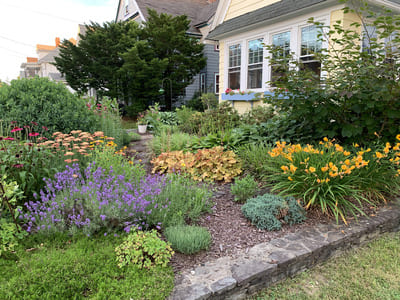
Inspiration came from Wendy's sister's urban front garden
I always loved urban yards that were entirely flower gardens. My sister converted her small front lawn into a beautiful flower garden that looked amazing all year long. While my suburban yard is a bit bigger than the typical urban front yard, I kept dreaming about ditching the lawn altogether. Grass isn’t meant to grow in our hot, dry, sandy environment. Native plants have evolved to live in this environment, so why not work with nature instead of fighting it? Joining Sustainable Saratoga’s pollinator group provided the ingredients I needed to make the dream a reality. I had comradery and shared expertise from some amazing women, and a supply of native plants. So, 2023 was the year I decided to just do it.
I spent a huge amount of time thinking about the garden design, which plants to use, how to create paths, and how to keep it natural but not so wild that it bothered my neighbors. I wanted to use this garden as an opportunity to show my neighbors that a mostly native flower garden/pollinator habitat can be a vibrant and beautiful alternative to the cookie cutter, low-diversity, boring American lawn.
Where did you get the plants for this project? And if you don’t mind telling us, how much did the 2023 garden expansion cost?
While I try to only plant native species now, I didn’t pull out the cultivars or the sentimental plants from my great-grandmother’s and my mother’s gardens. The new plants I’ve added in the last two years have mostly come from Sustainable Saratoga’s Pollinator Palooza native plant sale and from Wild Things Rescue Nursery in Valley Falls, NY. It is important to me that my plants are not treated with insecticides that can linger in the soil and be toxic to insects for a long time, so I only buy plants from reliable sources.
Adding a new 1800 square foot garden is not cheap, but it is a one-time expense. Mulch, compost, plants and equipment rental cost around $1700 – almost half of that was for the compost to try to increase the organic matter content of the sandy soils. I installed approximately 130 plants in the new garden, most of which were purchased, bringing my native species count up to 50. I added 36 of those species in the last two years, so you can see where my gardening interests are heading!
Do you have favorite plants in your garden?
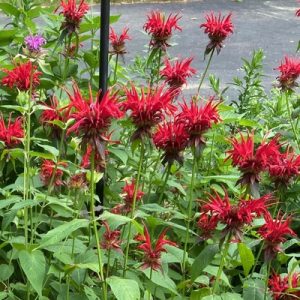
Oswego tea (Monarda didyma)
I wait for this one to flower every summer and soon after the hummingbirds show up and zip in and out of the garden and up to the dead oak branch above the garden. It is quite the show!
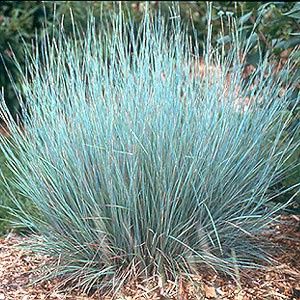
Little bluestem (Schizachyrium scoparium)
This is such a pretty bluish colored grass and I am nostalgic about it because I studied it in college.
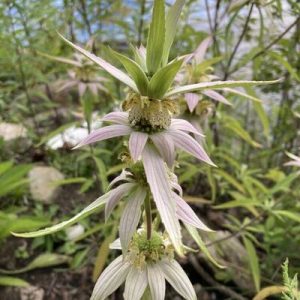
Spotted beebalm (Monarda punctata)
I only discovered this plant in 2022; I fell in love with the intricate flower that attracts huge iridescent golden digger wasps.
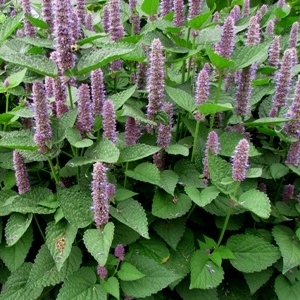
Anise hyssop (Agastache foeniculum)
This was one of my first plant purchases. Everything loves it – I love the smell; bees love the flowers; birds love the seeds in the fall and winter.
This looks like a back breaking project! Was it hard to remove the sod and make the garden beds?
The design aspect took a lot of time, mostly because I was stressing about how to create a positive example in the neighborhood. The physical work was surprisingly quick and easy. We rented a sod cutter for half a day to remove the grass, which we rolled up and gave away on a local Buy Nothing site; then we ordered 18 cubic yards of compost from Booth’s Blend Compost, which the whole family helped till into the soil and then spread another layer on top. After that, I started planting according to my design, with tweaks along the way as I found more native species to welcome into the garden.
Watering was essential for the first two months, especially with little rain and full sun exposure. By mid-summer, I had a bunny family move in and nibble away at some of my plants. They were not a welcome addition, but I did create a great buffet for them, so we are learning to live with each other. I put a temporary fence around some of the newer, more tender plants to keep the rabbits out until they had a chance to establish. I have done a little weeding throughout the summer to remove any grass or weeds that have popped up in the garden.
What has been the reaction from your neighbors?
I have gotten a lot of compliments, and quite a few people have commented that it looked like a lot of work. My experience is that once the plants are well-established, it really isn’t that much work. I do a little maintenance weeding and thinning in the spring, add a thin layer of compost to areas that need it, and that is about it. In a normal year, the plants don’t need any water because they are species that are accustomed to the dry, sunny, sandy environment they are growing in. And after a few years, I sometimes thin out plants that are spreading a little too much, which I give away to friends and neighbors.
I try to point out to curious passersby that the one of the most important changes anyone can make is to stop using pesticides. I think many people don’t make the connection that spraying to kill something they don’t want (mosquitos, ticks, etc.) is not only killing beneficial and desirable insects, such as butterflies, bees, dragonflies, and fireflies, but it is also harming the organisms that depend on insects for food (e.g., birds eating worms or grubs).
Do you have any advice for people who want to do this?
Small choices we can all make have a big impact – but these are three of the most important actions you can take to create a thriving habitat:
![]() Skip the pesticides – this might be the most important thing any of us can do.
Skip the pesticides – this might be the most important thing any of us can do.
![]() Add native plants, but don’t be too rigid – you can keep grandma’s peonies or roses.
Add native plants, but don’t be too rigid – you can keep grandma’s peonies or roses.
![]() Let your plants provide habitat and food throughout the winter – don’t clean up your gardens until late spring, leave the leaves and do not deadhead flowers – they provide seeds and shelter to insects and birds through the winter.
Let your plants provide habitat and food throughout the winter – don’t clean up your gardens until late spring, leave the leaves and do not deadhead flowers – they provide seeds and shelter to insects and birds through the winter.
Make a plan, but don’t stick to it! Embrace the reality that life is messy – plants don’t always follow the rules. They grow bigger or smaller than you think, and they don’t always thrive where you planted them, so don’t be afraid to move them around. And start small, there is always next year in the garden, so learn what you can and keep going until you are ready to expand. And remember that rabbits and other small mammals are important too, even though we might not like it when they eat our favorite new plant. At a minimum, they feed the owls and hawks!
Transformation timeline
Photos courtesy of Wendy Mahaney

